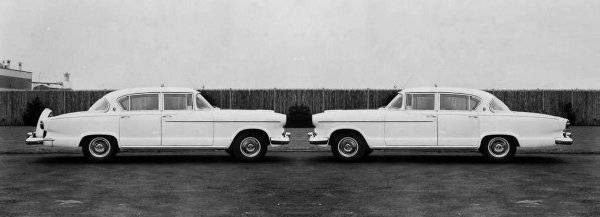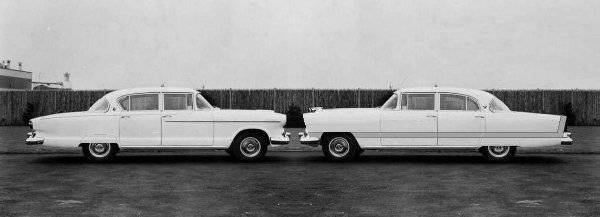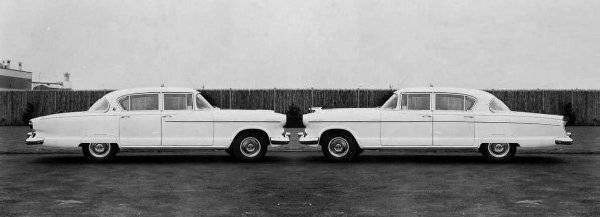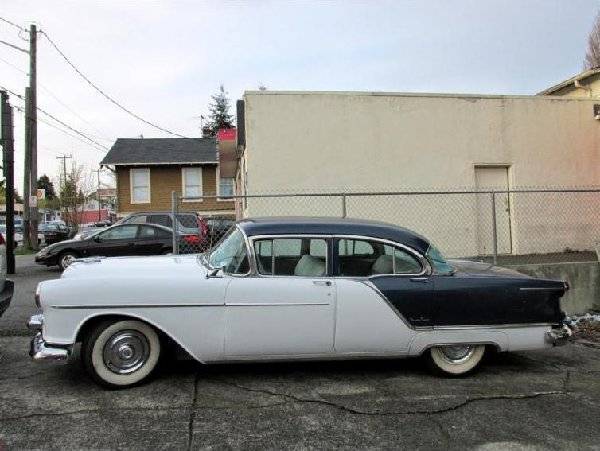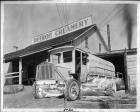|
Re: Nash-Hudson-Packard merger: observations and work-up
|
||||
|---|---|---|---|---|
|
Home away from home
|
I like those but first I heard that Hudson was ever part of the mix. I always thought it was Nash and Studebaker with Packard but that Nash got cold feet so paired off with Hudson instead which went on to become American Motors. By then, Packard had already bought (not merged with) Studebaker.
Posted on: 2019/1/27 2:36
|
|||
|
All generalities are false.
Once I thought I was wrong but I was mistaken. Don Pierson Packard / IMPERIAL page CA DMV Licensed Vehicle VIN Verification 1951 Henney-Packard 3-Door Long Wheelbase Air Force Ambulance The 1951 Henney-Packard is For Sale! 1954 Packard Patrician 1954 Packard Patrician Parts Car 1956 Clipper Custom Sedan |
||||
|
||||
|
Re: Nash-Hudson-Packard merger: observations and work-up
|
||||
|---|---|---|---|---|
|
Home away from home

|
There are lots of good sources that discuss the multi-year merger drama. The late Robert Neal's book on Packard 1951-54, Richard Langworth's book on post-war Hudson, and of course James Ward's book chronicling Packard's final years.
George Mason, President of Nash, had long been advocating merger of the Independents to better compete with the Big 3 and had approached Packard twice, at least. He and Jim Nance, who became Packard's President in May, 1952 had prior to that date apparently discussed merger strategy whereby Nash would acquire Hudson and Packard would secure Studebaker, then it all would be folded together. We may never know the full story but suffice to say, initially Nance was good with the idea of a Big 4th and likely envisioned himself eventually leading it. Mason also appears to have been good with all four being part of the merger initially. But at some point in 53-54 it appears that Nance soured on Hudson being a part of the deal and Mason soured on Studebaker due to that company's high labor costs and remote location, according to Neal. It's easy enough to see Mason's position, plus he already had a growing market for his Rambler in the low cost field. With Nance I have to wonder if his plan to morph Clipper into a stand-alone brand changed his opinion of Hudson, as they would have been in direct competition with each other and therefore redundant. Who knows. It all seems the big opportunity came and went in a historical blink of an eye. Here's a comparo of long deck Hudson, now with skirts and looking mighty fine, and Packard with all-in '55 styling, basically an all-new tophat. Am not sure they had the money or if such an outlay would have been wise, might have been throwing good money after bad. Better to wait for new architecture with much lower roof line and wider body. Why didn't Nance make a counter offer to Mason whereby Packard's vehicle platform and Hudson's plant would produce Packards, Ambassador and Hornet?
Posted on: 2019/1/27 18:37
|
|||
|
||||
|
Re: Nash-Hudson-Packard merger: observations and work-up
|
||||
|---|---|---|---|---|
|
Home away from home

|
Here's a lower cost approach to adding 3.75 inches to rear legroom: simply move the existing front and rear door sets forward 3.75 inches relative to rear wheels. The '57 Program was to use this method to separate Packard from Clipper. For the Nash-based vehicle it widens the C-pillar nicely, adding visual mass. Further cost savings were possible through sharing of Hudson door outers as shown.
Sharing those outers would have opened up the possibility for potential lower cost approach to adding 4 inches to axle-dash: tool only the Packard fenders and trim back 4 inches to create the Hudson fenders. Would have resulted in additional scrap in the body shop but might have delivered a net cost save. Appearance differentiation between Packard and Hudson forward of passenger compartment would have come from length of fenders and unique hood and grill. All told I think this would have been an affordable path to a decent Packard but it would have looked quite different from the car we are familiar with. Not sure Torsion-Level would have packaged in the Nash unibody but let's assume so. EDIT: added full length side trim to Packard.
Posted on: 2019/1/28 23:44
|
|||
|
||||
|
Re: Nash-Hudson-Packard merger: observations and work-up
|
||||
|---|---|---|---|---|
|
Home away from home

|
In those days car buyers wanted the latest thing. Any car that was a carry over from the previous year would see sales drop no matter how good it was. This is why GM went to a 3 year, then a 2 year model cycle with heavy face lifts in the years in between.
By 1955 the Hudson body was 7 years old, Nash was 4 years old, Packard was 5 years old. Studebaker was only 3 years old but was an avante garde design that never clicked with the public (except for the Loewy coupe). All the independents saw sales fall in the fifties, partly because of obsolescent styling and partly because of the forceful sales tactics used by Ford and GM in their battle for top selling car. If they had listened to Mason and gotten together in 1949 it might have been possible to have all new bodies by 1955. To compete with GM Ford and Chrysler as full line car companies they would have needed at least 3 different body shells or some variation. There are ways to stretch a body for higher priced models by replacing part of the body, in other words sharing some parts but not all. On the good side Studebaker had an excellent small V8 and Packard had a big one under development. Studebaker also developed a good automatic trans in cooperation with Borg Warner while Packard had the Ultramatic, both state of the art for the times. Nash had expertise in unit body construction and heating and air conditioning systems while Hudson was known for handling and performance. Packard did develop 320, 352 and 374 cu in V8s for Nash, Hudson, Studebaker and Packard while the Studebaker V8 was made in sizes from 224 to 289 cu in for smaller cars. I don't see the possible 55s as being versions of existing cars, but all new. If they had started planning earlier it might have been possible. I already described a possible Packard V12 based on the Studebaker V8 that would have been similar in size, displacement, horsepower and cost to Cadillac, Chrysler, and Lincoln V8 and could have been developed quickly with a small expense for tooling but that is another story. If they had taken that route it would have saved Packard 2 years and $5 million that they could have used elsewhere.
Posted on: 2019/1/31 3:35
|
|||
|
||||
|
Re: Nash-Hudson-Packard merger: observations and work-up
|
||||
|---|---|---|---|---|
|
Home away from home

|
Mason's merger idea was still valid even as late as 1953 but it was in its eleventh hour. For a chance to succeed, a good deal of rationalization was going to have to take place very rapidly to present a 1955 product line. Some things were going to have to give, there wasn't enough capital or financing to allow everything they might have wanted. All three makers were faced with significant plant underutilization being carried on diminishing volumes. One shared body shell was going to have to do for all three makes.
Not much doubt Mason would have pushed for all production to be consolidated at the Kenosha plant. Given his depth of automotive management experience, the post-merger BoD would have approved Mason's decision on this critical question. Where would this have left Nance? Either as second or third fiddle or, more likely, out the door with Romney leading the Hudson-Packard Division. Romney, as Mason's understudy with five years industry experience, was most likely to get the nod before would Nance. In the combined company, a Hudson-Packard Division was quite likely given their projected volume and market segments. It would have been analogous to the Lincoln-Mercury Division Ford created postwar. As far as Packard's Detroit operation, it would have been what we saw with all of Hudson manufacturing, engineering, sales; consolidation, shut-down and dispersal . As it was, by late '54-early '55 Romney faced the reality that AM could afford only one major platform revision and that was directed toward Rambler as their best potential hope. Hudson's contributions were doing little to stem their full-sized car sales decline, all in a year of unprecedented industry growth. Packard in this fold was unlike to get any major investments. But, as Paul has shown, a lengthened and re-skinned Airflyte was the only avenue the merged corporation could have afforded to pursue for a new Packard. The more they were able to disguise the basic shell's origins, the more likely it might have been accepted by loyal Packard buyers. The dreaded label "nameplate engineered" had to be avoided at all costs. Although they might not have disdained Nash Ambassador, Packard buyers had already bypassed it in favor of Packard 200/Clipper, holding it as a better value for their money. To return to exclusively the top spot of the merged corporation, Packard was going to have to relinquish some of its upper-medium-priced customers to Hudson. As long as there were any lower-priced versions of Packard, it was going to detract from its prestige reputation. Hudson could have functioned just fine as the upper-medium-priced, near luxury marque with a performance aura. Steve
Posted on: 2019/1/31 13:27
|
|||
|
.....epigram time.....
Proud 1953 Clipper Deluxe owner. Thinking about my next Packard, want a Clipper Deluxe Eight, manual shift with overdrive. |
||||
|
||||
|
Re: Nash-Hudson-Packard merger: observations and work-up
|
||||
|---|---|---|---|---|
|
Home away from home

|
Because Packard would have been looking at volumes of around 15K for '55 had they priced their 2 and 4 door Hudson-based cars at Four Hundred/Patrician level, dueled Packard-Hudson dealerships would have been a must. Perhaps offering T-L on the high end Hudson V8 might have enticed Clipper buyers to switch. This is where a good dealer would have helped, talking up the Packard content to a current Clipper owner wanting to trade but not finding a '55 upper-medium Packard on the showroom floor.
Looking at it all more broadly, in the lead-up to 1955 the bottom line was that between Packard, Hudson and Nash they needed to deliver one good family of V8s and one good body shell as basis for three differentiated series of cars. They made one attempt at the engine and succeeded, and had three chances at the body and failed. Packard's Contour was not fully competitive in appearance by '55, really wasn't everything it could have been even in 1951 which is too bad because it had tremendous potential as a Cadillac competitor. Nash's '52 Airflyte was an engineering tour-de-force but deficient in appearance, probably screw-ball to some though it did have its following. Seems the real problem was that Mason wasn't going to abandon it for '55, had too much invested. Given that Mason (appears to have) felt that Nash's car and construction method were superior (he was always pushing his car as basis for merger), it may not have mattered how early he got Packard to merge, the end result was destined to be a styling dud. Just like Barit over at Hudson. Or maybe not... Step-Down was stylistically outdated at the start of the 50's and certainly not the car to gamble the merger on in 1955, but it did have lowness going for it and even as late as '54 was selling fairly well against Packard and Nash. Which brings us to the third and final opportunity P-H-N had to create a winning body: the Jet. No, it wasn't a large car but by all rights should have been given the age of current Hudson. Consider the work-up below, which lengthens Jet to Clipper size, kind of even looks like the Clipper. Wheelbase increases from 105 to 122 inches, height is about 59.3 inches or 1.5 inches lower than Jet and one inch lower than '48 Step-Down. Backlight leans forward a bit and width would have increased 10-12 inches over Jet. Had such a car launched as the new Hornet in Spring, 1953 (which is when the Jet had launched) and demonstrated its sales potential over the next 6 months, I think everyone at P-H-N would have realized they had the competitive body shell needed to win in '55 (by which time a wrapped windshield would have been added). Ironically, it may well have been Mason and not Nance or Barit who balked at merger.
Posted on: 2019/2/1 20:54
|
|||
|
||||
|
Re: Nash-Hudson-Packard merger: observations and work-up
|
||||
|---|---|---|---|---|
|
Not too shy to talk
|
I've daydreamed quite a bit about the 4 companies & how they might have survived; even with hindsight it's a challenge to come up with a legitimate scenario. I like each company & wouldn't mind someday owning an example from each. My random thoughts:
-Did Hudson bring anything to American Motors that Nash couldn't have done on it's own? Sure, they picked up an additional dealer network, but was it worth the cost? -A Hudson-Studebaker marriage could have produced some interesting high-performance cars. Might the step-down replacement have looked better as a re-bodied Studebaker than a re-bodied Nash? Imagine a Hudson Hawk. -The only way I can see Packard surviving into the 60's would have been if they truly became the Rolls-Royce of the US: very limited production, very high end, very few model year changes. If, like RR, they could have become a major aircraft engine supplier they might have held on with the car business as a sideline. As it was, I don't think a Nash-based Packard could have competed against Cadillac/Lincoln/Imperial any better than the Packabaker. They really needed a home-run in '55-56, akin to "The Forward Look/Suddenly...it's 1960!" from Chrysler Corp in that time frame. They needed longer/lower/wider, not just matching the competition but beating it by a couple years. If Packard could have introduced, in 55/56, a car that looked like most any full-size car from 1960...it would have moved the needle.
Posted on: 2019/2/6 23:19
|
|||
|
||||
|
Re: Nash-Hudson-Packard merger: observations and work-up
|
||||
|---|---|---|---|---|
|
Home away from home

|
"They needed longer/lower/wider, not just matching the competition but beating it by a couple years."
Absolutely! Problem was, Packard and Nash had already blown their wad on new bodies in 51 and 52, respectively. Packard then had to focus on the V8 and settle for major refresh for 55 while Nash dollars went into longer wheelbase 4 door Rambler for 54 and new skin, front/rear glass and Hudson sheetmetal for large 55s. Hudson blew it all on the Jet when it could have simply shared with Rambler. They didn't work together!!! In my mind it was really Hudson who proved the biggest laggard, offering nothing except dealers, which eventually proved helpful to meeting Rambler sales records. And yet, of the three only Hudson had the mindset to go super low, which is why I think they should have been the go-to source for large bodies. It all could have worked just fine had they all simply copied GM, which had a very thoughtful sharing strategy that extended from Chevy all the way up to Cadillac. For example, correct me if wrong but all GM vehicles appear to have used the same windshield. Can you believe it? Here's the '54 Olds 98 that Nash, Hudson and Packard were looking at in late '53. It's a beautiful car and only around 60.5 inches tall. Rests on 126 wb vs 122 for 88 by moving rear wheels rearward 4 inches (you can see the take-up in the skirts) and increasing rear overhang by 5. Deck is therefore 9 inches longer. GM used this 2-step often. For example, Cadillac's 62 sedan road on a 129 wb and used a long roof. The 60 Special used same roof and 133 wb, again moving the rear wheels back 4 inches and increasing the rear overhang only this time by 7 inches, with 11 inch longer deck. Buick 40/60 shared with Olds 88 while 50/70 shared with Cadillac 62 except its rear wheels were moved 2 inches forward. The big Buicks and all Cadillacs positioned there windshields higher than the other GM cars.
Posted on: 2019/2/11 21:59
|
|||
|
||||
|
Re: Nash-Hudson-Packard merger: observations and work-up
|
||||
|---|---|---|---|---|
|
Home away from home
|
Not to stray too much, but what's interesting (to me, at least) is that my 1965 Cadillac Sixty Special with its 133" wheelbase parked next to my 1965 Imperial LeBaron with its 129" wheelbase, they look identical in overall length but the Imperial is far better proportioned and does not look as massive as it is. The Cadillac has a huge passenger compartment and gadgets such as climate control while Imperial had an excellent manual A/C and even had a second one optional at the rear which mine has.
Posted on: 2019/2/11 22:11
|
|||
|
All generalities are false.
Once I thought I was wrong but I was mistaken. Don Pierson Packard / IMPERIAL page CA DMV Licensed Vehicle VIN Verification 1951 Henney-Packard 3-Door Long Wheelbase Air Force Ambulance The 1951 Henney-Packard is For Sale! 1954 Packard Patrician 1954 Packard Patrician Parts Car 1956 Clipper Custom Sedan |
||||
|
||||

 (43.80 KB)
(43.80 KB)
